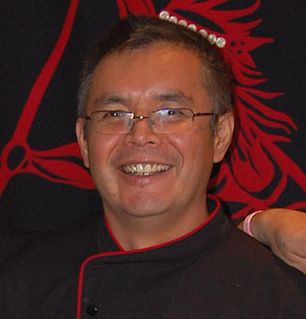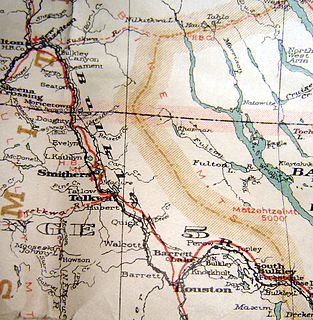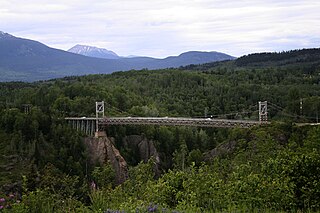
The Dakelh or Carrier are the indigenous people of a large portion of the Central Interior of British Columbia, Canada.

Hazelton is a village located at the junction of the Bulkley and Skeena Rivers in northern British Columbia, Canada. It was founded in 1866 and has a population of 305 (2011). The nearby larger community of New Hazelton is the northernmost point of the Yellowhead Highway, a major interprovincial highway which runs from Prince Rupert, British Columbia to Portage la Prairie, Manitoba.

The Skeena River is the second-longest river entirely within British Columbia, Canada. Since ancient times, the Skeena has been an important transportation artery, particularly for the Tsimshian and the Gitxsan—whose names mean "inside the Skeena River" and "people of the Skeena River," respectively. The river and its basin sustain a wide variety of fish, wildlife, and vegetation; and communities native to the area depend on the health of the river. The Tsimshian migrated to the Lower Skeena River, and the Gitxsan occupy territory of the Upper Skeena.

The Bulkley River in British Columbia is a major tributary of the Skeena River. The Bulkley is 257 kilometres (160 mi) long with a drainage basin covering 12,400 square kilometres (4,800 sq mi).

Andrew George Jr. is a Canadian chef and writer.

The Wetʼsuwetʼen are a First Nations people who live on the Bulkley River and around Burns Lake, Broman Lake, and François Lake in the northwestern Central Interior of British Columbia. The endonym Wetʼsuwetʼen means "People of the Wa Dzun Kwuh River ".

Houston is a forestry, mining and tourism town in the Bulkley Valley of the Northern Interior of British Columbia, Canada. Its urban population is approximately 3600 people, with approximately 2000 in the surrounding rural area. It is known as the "steelhead capital" and it has the world's largest fly fishing rod. Houston's tourism industry is largely based on ecotourism and Steelhead Park, situated along Highway 16. Houston is named in honour of the pioneer newspaperman John Houston.
Driftwood Canyon Provincial Park is a provincial park in British Columbia, Canada. Driftwood Canyon Provincial Park covers 23 ha of the Bulkley River Valley, on the east side of Driftwood Creek, a tributary of the Bulkley River, 10 km northeast of the town of Smithers. The park is accessible from Driftwood Road from Provincial Highway 16. It was created in 1967 by the donation of the land by the late Gordon Harvey (1913–1976) to protect fossil beds on the east side of Driftwood Creek. The beds were discovered around the beginning of the 20th century. The park lands are part of the asserted traditional territory of the Wet'suwet'en First Nation.

The Wetʼsuwetʼen First Nation is a Wetʼsuwetʼen First Nations band located outside of the village of Burns Lake, British Columbia, Canada. It was formerly known as the Broman Lake Indian Band and is still usually referred to as Broman Lake although this is no longer its official name. Its members speak the Wetʼsuwetʼen dialect of Babine-Witsuwitʼen, a Northern Athabaskan language. The main community is on Palling Indian Reserve No. 1.

The Bulkley Valley is in the northwest Central Interior of British Columbia, Canada.

Gitxsan are an Indigenous people in Canada whose home territory comprises most of the area known as the Skeena Country in English. Gitksan territory encompasses approximately 53,000 km2 (20,000 sq mi) of land, from the basin of the upper Skeena River from about Legate Creek to the Skeena's headwaters and its surrounding tributaries. Part of the Tsimshianic language group, their culture is considered to be part of the civilization of the Indigenous peoples of the Pacific Northwest Coast, although their territory lies in the Interior rather than on the Coast. They were at one time also known as the Interior Tsimshian, a term which also included the Nisga'a, the Gitxsan's neighbours to the north. Their neighbours to the west are the Tsimshian while to the east the Wetʼsuwetʼen, an Athapaskan people, with whom they have a long and deep relationship and shared political and cultural community.

The Witset First Nation is a First Nations band government of the Wet'suwet'en people of Witset, British Columbia, Canada. Their mailing address is in Smithers but their main community is at Witset.

New Hazelton is a district municipality on Highway 16 in northwest British Columbia, Canada. It is situated 133 km (83 mi) northeast of Terrace and 68 km (42 mi) northwest of Smithers and in 2016 had a population of 580 people, a decrease of 12.9% comparing to 2011. New Hazelton is one of the "Three Hazeltons", the other two being the original "Old" Hazelton located 6 km (4 mi) to the northwest very near to the confluence of the Skeena and Bulkley Rivers and South Hazelton, 5 km (3 mi) to the west.

Kitwanga or Gitwangak or Gitwangax is located where the Kitwanga River runs into the Skeena River in British Columbia. A long-standing village before contact, the village is within Gitwangak Indian Reserve No. 1.
Hagwilget Canyon is a canyon on the Bulkley River of northwestern British Columbia, Canada, located several kilometres upstream from that river's confluence with the Skeena River at Hazelton, at the Wet'suwet'en village of Hagwilget.
Hagwilget or Hagwilgyet is a First Nations reserve community of the Wet'suwet'en people located on the lower Bulkley River just east of Hazelton in northwestern British Columbia, Canada. The community's name means "well-dressed" as in "ostentatious," though another meaning is "the quiet people". It has also been spelled Awillgate and Ackwilgate and it has also been named Rocher Déboulé - "falling rock" - a reference to a landslide in this area from Rocher Déboulé Mountain, which blocked salmon runs on the Bulkley River at this location.

The Hagwilget Village First Nation is a First Nations band government of the Wet'suwet'en subgroup of the Dakelh (Carrier) people, located at Hagwilget, British Columbia, Canada, which is just east of Hazelton, British Columbia. The band is one of the 13 member governments of the Hereditary Chiefs of the Wet'suwet'en, which functions as a tribal council in alliance with the 35 members of the Hereditary Chiefs of the Gitxsan.

Hagwilget Canyon Bridge is a suspension bridge over the Hagwilget Canyon on the Bulkley River, at the Wet'suwet'en village of Hagwilget, British Columbia. The current bridge was constructed in 1931, and later reinforced in 1990.

The Unistʼotʼen Camp is a camp built on the territory of the Unist'otʼen clan of the Wetʼsuwetʼen First Nation peoples in northern British Columbia, Canada. It is located at the point where several planned energy pipelines will pass, as a means to block the crossing of Wetʼsuwetʼen territory by pipeline-related industries.
















